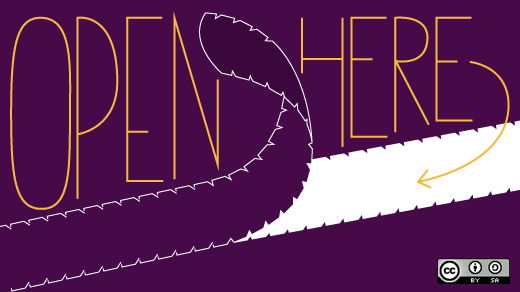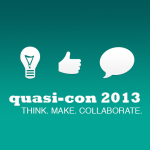Online, we know what open education looks like: P2PU, MOOC, Coursera, MITx—pick your favorite acronym. But, what does open education look like in person, and how do we capture its value in transferable artifacts with lasting impact?
At the University of Michigan School of Information, a group of students has been experimenting with leading unconferences as a site of professional development for librarians, archivists, and other information workers. We call these events Quasi-Cons, short for 'quasi-conference', and held our second this winter in Ann Arbor, Michigan, drawing nearly 70 students, alumni, and professionals for a day long mix of participant-driven discussion sessions, lightning talks, and panels.
With an egalitarian spirit, students and practitioners met to take up the current issues in their field. This year, the organizers set out to learn whether digital badging could help us document this on-the-fly informal learning experience.
By using badges, we hoped to extend the life of the conference, reveal important exchanges that often go unnoticed at large professional development events, and encourage new behaviors and exchanges among participants. In order to accomplish this, we took advantage of Mozilla’s Open Badges infrastructure, and created badges on badg.us that could then be easily displayed and shared using Mozilla’s Open Badge Backpack management platform.
For simple, appealing images for the badges, we relied on icons from The Noun Project, a resource that allows free use of artist-created graphics with attribution.
An important aspect of our badge system was our involvement in Quasi-Con’s planning from the very beginning. Rather than tacking on badges at the end as an afterthought to a completed conference plan, we were able to fully integrate badging into the event.
Badging sparks feedback
We created two tiers for the badges: Those based on attendees nominating other attendees to recognize certain qualities, and those based on individuals contributing creative content. To help attendees understand our implementation, we included documentation on the Quasi-Con website and gave a short presentation during the opening session.
What unfolded as a result of this system was exciting to experience. We saw a marked increase in digital conversation and interaction, fueled by our Online Ambassador badges, with participants tweeting thoughtful takeaways throughout the event. This democratic documentation of the conference provided invaluable feedback for presenters and conference planners about the impact of these learning experiences on participants.
Additionally, through our nomination-based badge system, participants recognized members of the community for the strengths they added to the event, allowing implicit social and educational processes—like mentorship or idea generation—to become explicit processes that the whole community could take part in.
Yet, what did the badging experience ultimately mean for attendees? We spoke with a few active badging participants after the conference. One, a recent graduate, reflected, "As for my future with badges you ask if I plan to stay involved in badging in the future. Well, my gut reaction is 'Um, I haven’t been that involved with badging in the first place.' But, as it turns out I earned 3 badges and am on my way to earning one more."
While she might not have initially noticed the connection between her activities and badging since she pursued them hand in hand, she became aware of the connected learning she experienced when looking back at her activities during the conference. This self realization sheds light on how badging can become a natural action rather than an extrinsic motivation.
In that sense, badges were a huge success.
Need for a global badging precedence
However, while most participants used a claim code to collect their digital badges after the event, not a single participant showcased their badges on the open web, as we suggested, via blogs or social networks. This finding brings up important issues that we have seen before in badging experiments: it’s difficult to communicate the value of these artifacts of informal learning, because there’s no current precedent for this kind of ecosystem.
More people seem familiar with accumulating badges in closed systems, where accomplishments carry weight only within a particular game or site that issues the badges. Within an Open Badges ecosystem, we want to remove any boundaries to the value that is placed on experiences represented by a digital badge.
As of the writing of this article, we cannot yet point to examples of why our conference badges are important outside our learning community, and this is a serious concern for future experimentation with Open Badges in other populations. Badges were inherently motivating for our participants, but we believe they can also be so much more.
Knowing the lively engagement badges engendered at Quasi-Con, we still encourage other professionals to experiment with similar models as we all strive to shift educational paradigms toward more open, connected, lifelong learning opportunities for all.
Read more about this experiment at the Universiity of Michigan, ALA Student Chapter website.
Editor's Note: The Noun Project is hosting an Iconathon design workshop on March 24 in Minneapolis, that will engage the design community and civic activists in creating what they call "badges of honor" to encourage recycling programs around the world.







Comments are closed.